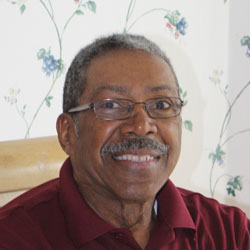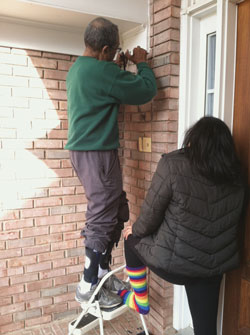 By Robyn Parets
By Robyn Parets
Some may think a midlife diagnosis of Charcot-Marie-Tooth (CMT) disease might necessitate a sedentary retirement. Not James Robinson, who learned he had CMT1A when he was about 52 years old.
“I don’t let it get me down or stop me from doing what I want to do,” said Robinson, now a 75-year-old retiree who lives in the Atlanta suburb of Stockbridge, GA, with his wife Julia.
The consummate optimist is no stranger to adversity. In fact, he learned to deal with challenges long before he was faced with his CMT diagnosis. Growing up in an impoverished neighborhood of Pittsburgh, PA, Robinson never graduated from high school and instead enlisted in the US Air Force at age 17. His father was ill at the time, and Robinson felt that by joining the military, he could learn new skills, serve his country, and help support his family. As it turned out, all of this proved to be true. Two months after leaving home, his father passed away. His mother was left alone with his three younger siblings. Robinson took over the role of family caretaker, even from afar.
He served in the Air Force for 24 years and became a computer systems manager. When he left the military in 1980, he settled in the Atlanta area. He and his wife raised three children and now have 12 grandchildren. Robinson worked for Georgia-Pacific as a computer systems specialist and kept in shape by jogging and playing racquetball.
 Soon after Robinson turned 50, he began noticing that he was losing his balance often. His hands and legs were much weaker than usual. When he played racquetball, he couldn’t control his swing, and he noticed that his gait was changing. Then he started to trip frequently, and fall down.
Soon after Robinson turned 50, he began noticing that he was losing his balance often. His hands and legs were much weaker than usual. When he played racquetball, he couldn’t control his swing, and he noticed that his gait was changing. Then he started to trip frequently, and fall down.
Robinson didn’t understand exactly what was going on, but he knew something was wrong. Then he remembered that one of his nieces in Philadelphia had had similar symptoms since she was young. He contacted her, learned about her CMT diagnosis, and upon her advice, went to see a neurologist.
That neurologist sent Robinson home with no answers or diagnosis, so he sought out a second opinion.
“The second doctor ordered a test to detect nerve speed and diagnosed me. He sent me to a specialist at Emory [University], who confirmed it,” he said.
Robinson’s form of CMT1A is the most common of the more than 80 known subtypes of the genetic neuropathy. He experiences all the symptoms typically associated with the inherited disease, including muscle weakness in the lower extremities and hands, high arches, numbness in the feet, and lack of balance. He has lost sensation in the tips of all of his fingers except his pinky fingers.
Although Robinson regularly does physical therapy to help alleviate some of his CMT symptoms, he said his Allard Blue Rocker ankle foot orthoses (AFOs) have made the biggest difference.
 “My confidence level has increased significantly. I have more stability and energy. I would not be able to walk from one side of the house to the other without them. Until they find a cure for CMT, these are a necessity [for me],” Robinson said.
“My confidence level has increased significantly. I have more stability and energy. I would not be able to walk from one side of the house to the other without them. Until they find a cure for CMT, these are a necessity [for me],” Robinson said.
Robinson, who also suffers from chronic back pain caused by spinal stenosis, said that although he may not be able to swing a racquet anymore, he still can still fix things and do projects around the house.
“With my lack of dexterity, it takes me three times as long, and I have to use both hands to pick things up. I have to be more patient and inventive at times,” he said. “But my attitude on life is to be positive.”
Robyn Parets is a freelance writer in the Boston area.
Photos by Susan Ruediger.








